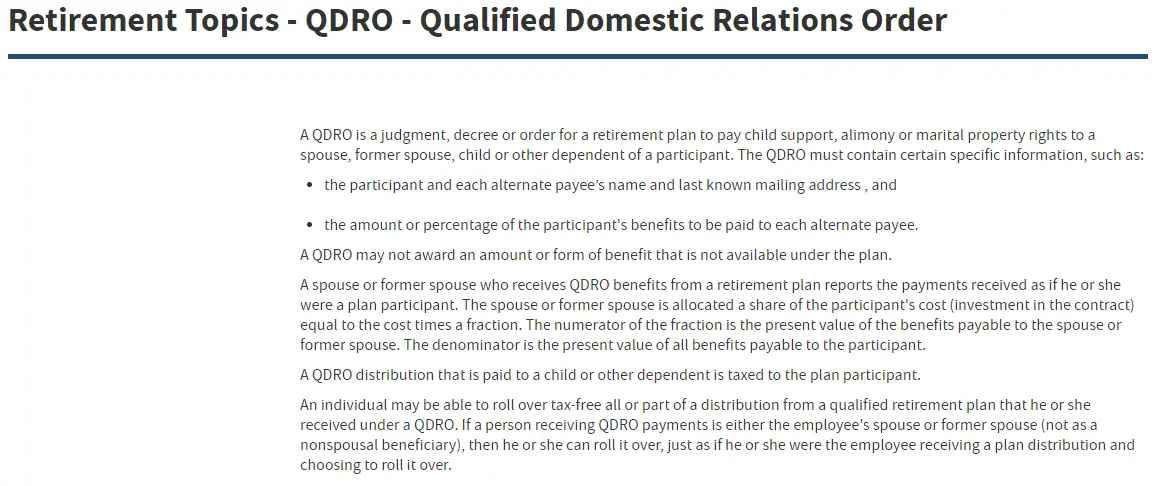In Marriage QDRO to Reduce Taxes or Invest in Real Estate
An In Marriage QDRO can reduce Required Minimum Distributions (RMDs) or otherwise allow you to access money inside a 401k (say, to invest in real estate).
Let’s talk about how a “In Marriage QDRO” might help you save in RMD! This new strategy can transfer a 401k from an older spouse to a younger partner’s spousal IRA, thus reducing RMDs!
Wait! An “In Marriage QDRO”???
If you have even heard of a QDRO before, you associate it with divorce. The word “divorce,” however, is not even mentioned in language used by the IRS or DOL when discussing QDROs.
A QDRO can be used by a happily married couple! The language clearly states “spouse or former spouse.” So, hence the term In Marriage QDRO to indicate that this strategy is for a spouse rather than a former spouse!
An In Marriage QDRO isn’t for everyone. In fact, most will find this a nuclear option with potential complications from your state and retirement plan. For a select few happily married folks with RMD problems, however, the In Marriage QDRO may be something to think about. It is a new way to think about QDRO RMD rules.
What is an “In Marriage QDRO”
What is a QDRO? Pronounced QUAD-RO, financial folks and lawyers must think I’m crazy! “But that’s what you get with a divorce!”
No, I’m not suggesting you get a divorce to save on taxes!
A Qualified Domestic Relations Order (QDRO) is what a judge uses to separate qualified (non-IRA) retirement accounts in a divorce. The judge signs a Domestic Relations Order and then the qualified plan administrator makes it Qualified (that is, it meets ERISA standards to be a QDRO).
There is nothing in the IRS regulations or the DOL rules (who administer ERISA) that mandate QDROs are only for divorce. In fact, they can be used for spouses in addition to former spouses. This is not a loophole! It is a specified (but previously unused) portion of the law.
Let’s look at the IRS web page for guidance.
The IRS, DOL and QDROs

Figure 1 (The IRS and In Marriage QDROs)
Note from the IRS Website, whenever they mention marital property rights, they specify that it can go to a spouse or former spouse.
From the DOL Website, we read that a “domestic relations order” includes the approval of a property settlement. This is made under state domestic relations law (including community property law).
Translating lawyer-to-English, this means that the state’s family law regulations MAY allow transfer of property from one spouse to another as a marital property right. Another way to say it: if I have a 401k, state law may permit me to get a domestic relations order from a judge giving my spouse the right to withdrawal part of the money. Since the withdrawal is part of a QDRO, by definition it comes out penalty free! In addition, my spouse can roll it over to a spousal IRA and treat it as his or her own.
Considerations and Definition of In Marriage QDRO
An In Marriage QDRO is defined as state-sanctioned ERISA-mandated interspousal agreement. You don’t need a divorce to get one as we saw in the IRS and DOL language above. In Marriage QDROs are also called “QDROs for the happily married” and one company has actually trademarked the term “In-Marriage QDRO®.”
Please note, this is state specific. For instance, the happily married plan is for NY and apparently involves getting a judge to sign a QDRO after initiating divorce proceedings, but dropping the divorce proceeding after the QDRO is signed. The “In-Marriage QDRO®” may work better in community property states. In these states, half of the 401k is, by community rights, already owned by the spouse. Here is a PowerPoint on the topic.
Your state needs to have domestic relation laws that either allow postnuptial agreements, or agreements that assign personal marital property to the non-participating spouse. These domestic relations statues are found in the state’s family code. See a lawyer in your state who is familiar with family law. Or, conversely, and estate lawyer may contemplate a In Marriage QDRO. For sure, don’t take legal advice from the internet!
Federal law applies via ERISA. While not getting into the details, congress writes the law and the IRS and DOL write regulations or rules. Your plan administrator must ensure the domestic relations order meets ERISA guidelines. They don’t, however, decide if an alternate payee is appropriate or not, just if the order follows ERISA guidelines for QDROs.
Who might Benefit from an In Marriage QDRO?
Aside from delaying RMDs if you have a younger spouse—the subject of this article—there are several other potential uses of an In Marriage QDRO.
- Accelerate RMDs by passing retirement assets to an older spouse. This can avoid penalties on withdrawals prior to the age of 59 ½
- Medicaid spend-down planning (transfer for the benefit of the community spouse)
- Special needs trust planning (remove money from qualified accounts to fund trust)
- Access prior to 59 ½
- for real estate investment in a self-directed IRA or brokerage account
- for early retirement income without penalties
- instead of liquidating and paying penalties
- Mortgage Acceleration to help pay off the mortgage without penalty
Note that you can transfer the qualified money either into either a spousal IRA (and keep the pre-tax treatment) OR transfer to money into a brokerage account (and pay taxes now). Again, there is no 10% penalty because a QDRO is a specific exemption to this penalty.
Summary: A New Strategy to Reduce RMD Taxes: “In Marriage QDRO”
A In Marriage QDRO is a new strategy to reduce RMDs, but as you can see above there are other uses as well.
QDROs are exempt from the 10% penalty so the 401k funds come out penalty free. A spouse can keep the funds in a spousal IRA or pay taxes and transfer it to a taxable account. QDRO RMD rules are favorable.
Comparing an In Marriage QDRO to traditional strategies to reduce RMDs, you can see potential and great flexibility with the In Marriage QDRO.
Nothing in the regulations mandate that QDROs be used just for divorce, but more likely than not this strategy has not been attempted in your state of residence. If you approach a lawyer with this suggestion, you are likely to be met with incredulity, consternation, or worse.
If you are looking for a nuclear option to free your 401k and transfer it to your spouse, consider the tax advantages of a In Marriage QDRO.
